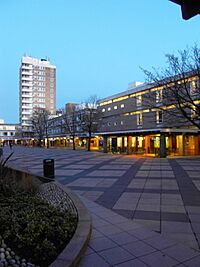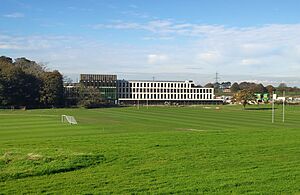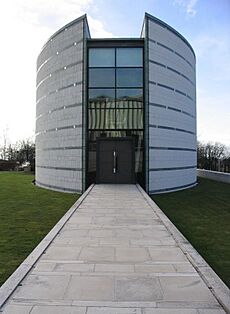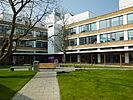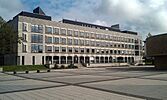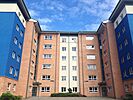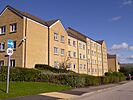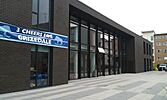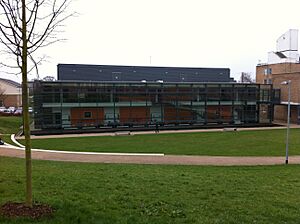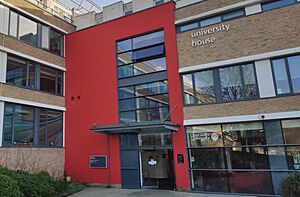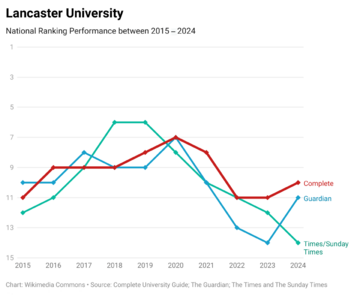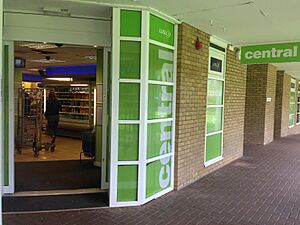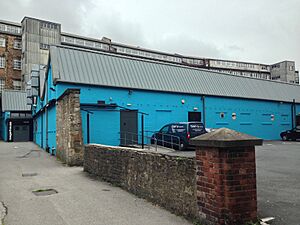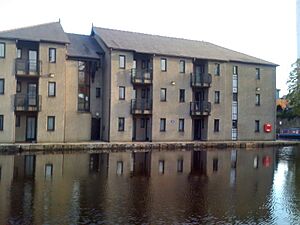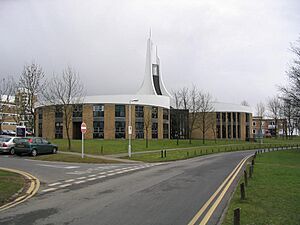Lancaster University facts for kids
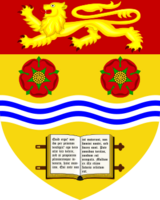
Coat of arms of Lancaster University
|
|||||||||||||||||||||||
| Motto | Latin: Patet omnibus veritas | ||||||||||||||||||||||
|---|---|---|---|---|---|---|---|---|---|---|---|---|---|---|---|---|---|---|---|---|---|---|---|
|
Motto in English
|
Truth lies open to all | ||||||||||||||||||||||
| Type | Public | ||||||||||||||||||||||
| Established | 1964 | ||||||||||||||||||||||
| Endowment | £18.9 million (2024) | ||||||||||||||||||||||
| Budget | £401.7 million (2023/24) | ||||||||||||||||||||||
| Chancellor | Alan Milburn | ||||||||||||||||||||||
| Vice-Chancellor | Andy Schofield | ||||||||||||||||||||||
| Pro-Chancellor | Alistair Burt | ||||||||||||||||||||||
|
Academic staff
|
2,320 (2023/24) | ||||||||||||||||||||||
|
Administrative staff
|
2,090 (2023/24) | ||||||||||||||||||||||
| Students | (2015/16) 16,615 FTE (2015/16) |
||||||||||||||||||||||
| Undergraduates | (2015/16) | ||||||||||||||||||||||
| Postgraduates | (2015/16) | ||||||||||||||||||||||
| Location |
Bailrigg, City of Lancaster
,
England
54°00′37″N 2°47′08″W / 54.01028°N 2.78556°W |
||||||||||||||||||||||
| Campus | Bailrigg | ||||||||||||||||||||||
| Colours | 'Quaker Grey' and red Colleges
Bowland
Cartmel |
||||||||||||||||||||||
| Affiliations |
|
||||||||||||||||||||||
 |
|||||||||||||||||||||||
Lancaster University is a public research university located in Lancaster, Lancashire, England. It was started in 1964 by a special document called a royal charter. This made it one of several new universities created in the 1960s.
The university first operated in the city center. In 1967, it began moving to a new campus built just for it. This campus is on 300 acres at Bailrigg, about 4 miles south of the city. The buildings on campus are connected by a main path called the Spine. This path leads to a central area named Alexandra Square, honoring the university's first leader, Princess Alexandra.
Lancaster is a residential collegiate university. This means it has different colleges where students live and study. The eight colleges for undergraduate students are named after places in the historic area of Lancashire. Each college has its own student housing, common rooms, staff, and places to relax.
Lancaster University has been ranked among the top universities in the UK for many years. It also received a Gold rating for its teaching quality in 2017 and 2023. The university's income for 2023/24 was over £401 million. A part of this, £48.5 million, came from research projects.
Lancaster is part of the N8 Group, which is a group of eight research universities. Other universities in this group include Durham, Leeds, and Manchester. Since 2015, Alan Milburn has been the university's Chancellor, which is a ceremonial leader.
Contents
University History
Between 1958 and 1961, seven new universities were planned in the UK, including Lancaster. The decision to build a university in Lancaster was announced on November 23, 1961.

The university officially started with a royal charter in 1964. This charter stated that Princess Alexandra of Kent would be the first Chancellor. She officially took on the role in 1964. During her inauguration, important people, including the Prime Minister Harold Wilson, received special honorary degrees.
Princess Alexandra retired as Chancellor in 2004. She was the longest-serving Chancellor of any British university at that time. When she left, she allowed the Chancellor's Medal to be given to top-performing students. Each year, up to five master's students and six undergraduate students receive this award.
The university welcomed its first students in October 1964. At first, there were 13 professors and 32 other teaching staff. The university's motto, "patet omnibus veritas", means "Truth lies open to all." The first science students joined in 1965.
The university was temporarily located in the city center. A lecture hall and the first student common room were in an old church. Many new students lived in the nearby town of Morecambe. The Grand Theatre was used as a main lecture room. The library was in old workshops on Castle Hill.
Bowland and Lonsdale were the first two colleges, founded in 1964. All staff and students were assigned to one of these colleges. The first college buildings were finished in 1966. Students began living in these buildings in October 1968.
The university moved from the city to its new campus at Bailrigg between 1966 and 1970.
In 2014, Lancaster University celebrated its 50th birthday. Many events were held throughout the year for former students, staff, current students, and local community members.
University Campus
<mapframe latitude="54.030007" longitude="-2.793489" zoom="13" width="251" height="569" align="right" text="Locations of various Lancaster University and LUSU owned and affiliated buildings and facilities in Lancaster"> { "type": "FeatureCollection", "features": [ { "type": "Feature", "properties": { "title": "Sports Centre" }, "geometry": { "type": "Point", "coordinates": [ -2.792025, 54.012655 ] } }, { "type": "Feature", "properties": { "title": "Bailrigg Campus" }, "geometry": { "type": "Polygon", "coordinates": [ [ [ -2.789154, 54.006154 ], [ -2.789457, 54.014233 ], [ -2.781215, 54.014233 ], [ -2.781258, 54.006205 ], [ -2.789154, 54.006154 ] ] ] } }, { "type": "Feature", "properties": { "title": "The Sugarhouse" }, "geometry": { "type": "Point", "coordinates": [ -2.796787, 54.051046 ] } }, { "type": "Feature", "properties": { "marker-symbol": "castle", "title": "University Base at Lancaster Castle" }, "geometry": { "type": "Point", "coordinates": [ -2.805309, 54.049821 ] } }, { "type": "Feature", "properties": { "title": "Health Innovation Centre" }, "geometry": { "type": "Point", "coordinates": [ -2.791768, 54.015632 ] } }, { "type": "Feature", "properties": { "title": "Chancellor's Wharf" }, "geometry": { "type": "Point", "coordinates": [ -2.801586, 54.043287 ] } }, { "type": "Feature", "properties": { "title": "Alexandra Park" }, "geometry": { "type": "Polygon", "coordinates": [ [ [ -2.79059, 54.002776 ], [ -2.79059, 54.005523 ], [ -2.785825, 54.005523 ], [ -2.785825, 54.002776 ], [ -2.79059, 54.002776 ] ] ] } } ] } </mapframe>
Bailrigg Campus
The main campus is at Bailrigg. It covers 360 acres and was given to the university by Lancaster City Council in 1963. The campus buildings are on a hilltop. The lower parts of the hill have parks, including Lake Carter, a duck pond, and sports fields. Lake Carter was named after Charles Carter, the university's first Vice Chancellor. The campus is about 3 miles south of the city center. Building started in November 1965, and the first building was ready a year later. Student homes on campus opened in 1968.
Bailrigg was designed so that social, living, and teaching areas are all connected. There isn't one big student union building. Instead, each college has its own spaces for fun and activities.
Cars and people use separate paths. Cars stay on a road around the edge of campus. There's an underpass that goes under Alexandra Square for buses. This helps keep people walking safe.
The campus buildings are arranged around a main path called "The Spine." This path runs from north to south-west and is covered for most of its length. This design helps protect people from bad weather.
Alexandra Square is the main open area on campus. It's named after the first Chancellor, Princess Alexandra. University House, banks, and shops are on one side of the square. The tallest building on campus, the fourteen-story Bowland Tower, is also nearby.
One unique building at Bailrigg is the Lancaster University Chaplaincy Centre. It opened in 1969. The building has a special three-leaf shape with a spire in the middle. The university's old logo was based on this spire.
University Library
The university library is in the south-west corner of campus. It was designed in 1964 and opened in phases between 1966 and 1971. The library was expanded in 1997 and updated between 2014 and 2016. In 2021, a new extension added more study spaces and a 'living wall'.
A special feature of the library is a large tree that grows inside the main study area on the ground floor.
Next to the library is The Ruskin - Library, Museum and Research Centre. It opened in 1998 and was designed by Sir Richard MacCormac.
South-West Campus Area
The university started to expand onto the lower parts of Bailrigg. New buildings for Graduate College were built in 1998. This area is now part of the South-West Campus. More buildings were added, including InfoLab21 and Alexandra Park. Alexandra Park now has Lonsdale College, Cartmel College, and modern rooms for Pendle College.
Cartmel College is built around Barker House Farm. This is a 17th-century farmhouse and other old buildings that are now part of the college.
Health Innovation Centre
The university built a 'Health Innovation Campus' next to the main campus. This campus is expected to create 2,000 jobs and boost the local economy. Construction of the first building started in December 2017 and was finished in summer 2020.
Campus Services
The Bailrigg campus has many shops and services for students and staff. These include a post office, a health center, a pharmacy, hairdressers, and a university housing office.
Arts and Culture Venues
At the north end of campus, the university has the Great Hall Complex. This includes three places for performances and art that are open to everyone. These are the Peter Scott Gallery, the Nuffield Theatre, and the Lancaster International Concert Series. In 2015, these were all brought together under the name 'Lancaster Arts at Lancaster University'.
The Peter Scott Gallery is free to visit. It holds the university's art collection, which includes Japanese and Chinese art, old objects, and works by British artists.
The Lancaster International Concert Series offers classical music concerts. These concerts are held in the Great Hall from October to March each year. They feature orchestral music, chamber music, jazz, and world music.
The Nuffield Theatre is a large and flexible professional studio theatre. It hosts public shows of theatre, dance, and live art from companies around the UK and other countries. It focuses on new and experimental performances. Students also perform here.
The Ruskin - Library, Museum and Research Centre keeps old papers and items related to the poet, author, and artist John Ruskin. It is open to the public, but only a small part of the collection is shown at one time. The building was built in 1997 by architect Sir Richard MacCormac.
Conference Centre
In 2016, the university bought the Forrest Hills conference center and golf course. It is located across from the main campus and is still used for conferences.
University Structure
University Colleges
- Colleges of Lancaster University
The university has nine colleges. These colleges provide housing, support, social life, and help with student rules. All students and staff belong to a college. Most colleges have around 800 to 900 members. All on-campus housing is connected to a college.
Before 1992, the eight colleges housed both undergraduate (first-degree) and postgraduate (advanced-degree) students. In 1992, the ninth college, Graduate College, was created just for postgraduate students. This college helps meet the needs of students doing advanced degrees. Students doing "integrated master's degrees" are still considered undergraduates and stay in their original colleges.
Seven of the eight undergraduate colleges are named after areas in the historic county of Lancashire. County College is named after the Lancashire County Council, which helped pay for its construction.
| Name | Foundation | Colours | Students (2024/25) | Named after |
|---|---|---|---|---|
| Bowland College | 1964 | 1,677 | Forest of Bowland | |
| Cartmel College | 1968 | 1,880 | Cartmel Peninsula | |
| The County College | 1967 | 1,900 | Lancashire | |
| Furness College | 1966 | 1,500 | Furness region | |
| Fylde College | 1968 | 1,590 | The Fylde peninsula | |
| Graduate College | 1992 | 5,212 | Status as a postgraduate college | |
| Grizedale College | 1975 | 1,478 | Grizedale Forest | |
| Lonsdale College | 1964 | 1,990 | Lonsdale Hundred (River Lune and its valley) | |
| Pendle College | 1974 | 1,660 | Pendle region |
The college buildings also house some academic departments. However, they are mainly for social activities and student housing. Each college has its own bar.
Academic Departments
The university is divided into four main groups called faculties. Each faculty has a Dean, and each academic department has a Head.
- Faculty of Arts and Social Sciences
- Department of Educational Research
- Department of English Literature and Creative Writing
- Department of History
- Lancaster Institute for the Contemporary Arts (LICA)
- Art, Design, Film, Theatre, Architecture
- School of Global Affairs
- Lancaster University Law School
- Department of Linguistics and English Language
- Department of Politics, Philosophy and Religion
- Department of Sociology
- Faculty of Health and Medicine
- Division of Biomedical and Life Sciences
- Division of Health Research
- Lancaster Medical School
- Faculty of Science and Technology
- Department of Chemistry
- School of Computing and Communications (SCC)
- Department of Engineering
- Lancaster Environment Centre
- (Biological Sciences, Environmental Science, Geography)
- Department of Mathematics and Statistics
- Natural Sciences
- Department of Physics
- Department of Psychology
- Lancaster University Management School
- Accounting and Finance
- Centre for Education, Training and Development (CETAD)
- Department of Economics
- Department of Entrepreneurship, Strategy and Innovation
- Department of Leadership and Management
- Department of Management Science
- Department of Marketing
- Department of Organisation, Work and Technology
Other departments that support the university, like Facilities and the Library, are called Professional Services.
University Leadership
The university is managed by two main groups: the Council and the Senate.
The Council is the main governing body. It includes people from outside the university, as well as staff and students. It makes sure the university is managed well and has enough money.
The Senate is the main academic authority. It manages academic programs and sets goals for teaching and learning. Members of the Senate include the Deans of faculties and heads of academic departments.
The Visitor
The "Visitor" of the university is the King of the United Kingdom, currently King Charles III. The Visitor is the final person to decide on any disagreements within the university.
The Chancellor
The Chancellor is the formal and ceremonial head of the university. Currently, this is Alan Milburn.
Former Chancellor Sir Chris Bonington now serves as the Chancellor's Ambassador. Alistair Burt is the current Pro-Chancellor and leads the University Council.
| Name | Duration |
|---|---|
| Princess Alexandra, The Hon Lady Ogilvy | 1964–2004 |
| Sir Christian Bonington | 2005–2014 |
| Alan Milburn | 2015–present |
The Vice-Chancellor
The Vice-Chancellor is the chief academic and executive officer of the university. This person leads the university's daily operations and academic work. Andrew John Schofield became Vice-Chancellor in May 2020. He announced his resignation, effective August 2025. Steve Decent will take over in January 2026.
| Name | Duration |
|---|---|
| Sir Charles Carter | 1964–1980 |
| Philip Reynolds | 1980–1985 |
| Harry Hanham | 1985–1995 |
| William Ritchie | 1995–2002 |
| Paul Wellings | 2002–2011 |
| Mark Smith | 2011–2019 |
| Andy Schofield | 2020– |
University Finances
In the financial year ending July 31, 2024, Lancaster University had a total income of £401.7 million. Its total spending was £290.7 million. Most of its income came from student tuition fees and education contracts. It also received money from government grants and research projects.
Academic Information
Student Admissions
|
| Domicile and Ethnicity | Total | ||
|---|---|---|---|
| British White | 56% |
|
|
| British Ethnic Minorities | 19% |
|
|
| International EU | 4% |
|
|
| International Non-EU | 21% |
|
|
| Undergraduate Widening Participation Indicators | |||
| Female | 45% |
|
|
| Independent School | 10% |
|
|
| Low Participation Areas | 9% |
|
|
Lancaster is a popular university. In 2014, it ranked 25th in Britain for the average entry scores of its new students. Most courses require high grades, like AAA or AAB at A-level.
In the 2023/24 school year, Lancaster had over 17,000 students. About 13,000 were undergraduates and over 4,000 were postgraduates. In 2016–17, about 66% of students were from the UK, 10% from the EU, and 23% from other countries. The number of female and male students was almost equal.
University Rankings
| National rankings | |
|---|---|
| Complete (2021) | 10 |
| Guardian (2021) | 11 |
| Times / Sunday Times (2021) | 12 |
| Global rankings | |
| ARWU (2020) | 301–400 |
| CWTS Leiden (2020) | 87 |
| QS (2021) |
157 |
| THE (2021) | 168= |
| British Government assessment | |
| Teaching Excellence Framework | Gold |
Lancaster University has consistently been ranked among the top universities in the UK. For the past 10 years, it has been in the top 15 in all three major UK university rankings. It is also often in the top 150 universities worldwide. It has been the top university in the north-west of England for ten years in a row.
In 2014, when it turned 50, Lancaster University was ranked 10th in a list of the world's best universities under 50 years old.
Joint Programs
Lancaster University works with other universities around the world. Since 2006, it has offered dual degree programs with Sunway University in Malaysia.
It also had a dual degree program with COMSATS Institute of Information Technology (CIIT) in Pakistan. Students could earn degrees from both universities. This program has since ended.
In 2017, Lancaster partnered with University Academy 92 (UA92). This project was started by famous Manchester United soccer players. Lancaster now teaches media, sport, business, and psychology at a new campus in Manchester.
Programs Abroad
In October 2013, Lancaster University opened a campus in Accra, Ghana. This campus offers British university-level education to students in Ghana and across Africa. It has programs in business, economics, computer science, law, and psychology.
In 2020, Lancaster opened a new campus in Germany, called Lancaster University Leipzig. The programs there are the same as those in Lancaster, and students get their degree from Lancaster University.
Lancaster also opened the Joint Institute for Environmental Research and Education (JIE) in Guangzhou, China, in 2016. This is a partnership with the South China Agricultural University. Students can study Environmental Science and spend two years at each university.
In April 2016, the Chinese Ministry of Education allowed Lancaster to create Lancaster University College - Beijing Jiaotong University in Weihai, China.
University Research
Lancaster's research income for 2021-22 was £48.1 million. In a 2014 review of UK university research, Lancaster was ranked 18th out of 128 universities. It was also 13th for the amount of "world-leading" research it does. The university focuses on research that combines different subjects.
In 2012, Lancaster University partnered with BAE Systems, a large defense company, and four other universities. They work on the Gamma Programme, which develops "autonomous systems." These are technology solutions that can do tasks on their own, like in aerospace or nuclear industries.
Physics Research
Lancaster University's Physics Department has highly rated research. About 46% of its research is considered "world-leading." The department has five main research groups, including astrophysics and particle physics. The Particle Physics Research Division works with major research centers like CERN and Fermilab.
Student Life
Students' Union
Lancaster University Students' Union (LUSU) represents all students at the university. Unlike some universities, there isn't one main union building. Instead, the union works through the eight college JCRs, which each have their own social spaces. The union does have an administration building. SCAN (Student Comments And News) is the union's newspaper, started in 1967.
LUSU owns a nightclub in Lancaster called The Sugarhouse. It also runs a shop on campus, LUSU Shop, and an off-campus housing agency called LUSU Living.
LUSU also supports LUSU Involve, a program that helps students volunteer in local and international communities.
There are over 175 different student societies at Lancaster University. These include groups for sports, hobbies, politics, academics, culture, and religion. During the Freshers (new student) period, many clubs and societies promote themselves.
Chancellor's Wharf Housing
Chancellor's Wharf is student housing located off-campus. It has three buildings next to the Lancaster canal. This location is close to the city center. Students living here are still members of their university colleges.
University Sports
Every summer, students take part in the Roses Tournament against the University of York. This is often called the biggest university sports competition in Europe. The event takes place at Lancaster and York in alternating years. It is named after the 15th-century War of the Roses.
Lancaster University Athletics Club (LUAC) started in May 2011. The club has won awards and competes in university sports events.
Lancaster University Swimming and Water Polo Club (LUSWP) competes in swimming and water polo events. The swimming team also takes part in charity galas. The water polo team competes in the UPOLO league. LUSWP won the university's 'Club of the Year' award in 2015/2016 and 2016/2017.
Intercollegiate Sports
There are many sports events between the different colleges at the university. There are leagues for football, netball, pool, darts, and dominoes. Pool, darts, and dominoes together form a "bar sports" league called the George Wyatt Cup. The Carter Shield is a fun competition between all colleges, held every two weeks, to encourage participation in less common sports.
There are also annual sports events between specific colleges:
- Founders is a competition between Bowland and Lonsdale, the two oldest colleges. It started in 2004 to keep their friendly rivalry going.
- Legends used to be a competition between Grizedale, County, Pendle, and Fylde colleges. After some changes, it was replaced by Titans (County/Fylde) and Warriors (Grizedale/Pendle).
- Patriots is a competition between Furness and Cartmel Colleges.
Arts, Media, and Culture
Besides sports, Lancaster University has many arts societies for performance, media, and music. Examples include the Lancaster University Theatre Group (LUTG), the Comedy Institute, and the University of Lancaster Music society (ULMS). There are also groups for dance.
The university has four main student media groups: the student radio station Bailrigg FM, the student newspaper SCAN (started in 1967), and the student union's television station LA1TV. There is also Take 2 Cinema, an on-campus cinema.
Religious Groups
The Lancaster University Chaplaincy Centre is at the north end of campus. It includes various religious groups like Christian (Anglicans, Catholics, Orthodox, Quakers), Jewish, Buddhist, and Hindu. There are also many religious societies that hold regular events. The Islamic Prayer Rooms are located near the Chaplaincy Centre.
Notable People
Alumni
Business Leaders
- W. Brian Arthur, Operational Research (1967) – Economist
- Antony Burgmans, Marketing (1971, Bowland) – Former Chairman of Unilever
- Jon Moulton, Chemistry (1973, Furness) – Founder, Better Capital
- Mark Price, Classics & Archaeology (1982, Bowland) – Managing Director of Waitrose
- Bruce Sewell, Psychology (1979, Bowland) – Former Senior Vice President and General Counsel, Apple
- Ashni Singh, Accounting and Finance (2000, Graduate College) - Minister of Finance, Guyana
- Nahed Taher, Economics (2001, Graduate College) – CEO, Gulf One Investment
Media Personalities
- Richard Allinson, Economics (1980, Fylde) – Radio presenter
- Robert Fisk, English Literature (1968, Lonsdale) – Middle East correspondent for The Independent
- James May, Music (1985, Pendle) – Television presenter
- Ranvir Singh, English and Philosophy (1998, Pendle) – Television presenter
Artists and Performers
- Roger Ashton-Griffiths, Music (1978, Furness) – Actor
- Lucy Briers, Independent Studies (1988, Cartmel) – Actress
- Joseph Delaney, English (1975, Lonsdale) – Writer
- Emily Fleeshman, Theatre Studies (2007) – Actress
- Rainer Hersch, Economics (1985, Cartmel) – Comedian and musician
- Ralph Ineson, Theatre Studies (1991, Furness) – Actor
- Daniel Ings, Theatre Studies (2008) – Actor, including in Netflix series The Gentlemen.
- Andrew Miller, Creative Writing (1997) – Novelist
- Piri, Chemistry (2020) – Musician
- Andy Serkis, Independent Studies (1985, County) – Actor. He is one of the highest-grossing actors of all time.
- Dean Sullivan, Teaching Degree – Actor (Played Jimmy Corkhill in Brookside)
- Sarah Waters, English Literature (1988, Graduate College) – Author
Politicians and Legal Professionals
- Taye Atske Selassie, PhD in Political Science, International Relations, and Strategic Studies – President of Ethiopia
- Audrey Azoulay, Business Administration (1993) – French politician and former Minister of Culture
- Paul Bristow, History and Politics (Cartmel) – Former Member of Parliament (MP) for Peterborough
- Sir Alan Campbell, Politics (1978, Furness) – MP for Tynemouth
- Rami Hamdallah, Linguistics (1988, Graduate College) – Former Prime Minister of the Palestinian National Authority
- Ruth Henig, Baroness Henig, PhD in history (1978) – Academic and Deputy Speaker in the House of Lords
- Alan Milburn, History (1979, Pendle) – Chancellor of Lancaster University and former MP for Darlington
- Cat Smith, Sociology and Gender Studies (2006, Cartmel) – MP for Lancaster and Fleetwood
- Christian Wakeford – Politics (2007, Grizedale) – MP for Bury South
Sports Figures
- Louie Hinchliffe – Team GB athlete
- Jason Queally MBE, Biological Sciences (1992, Bowland) – Cyclist
Scientists and Academics
- Paul Baker, PhD in Applied Linguistics – Professor of Linguistics, Lancaster University
- Sarah Mercer, Phd in Applied linguistics (2008) – Professor of Linguistics, University of Graz
- Lucy Rogers, BEng Engineering (1995, Fylde) and PhD in engineering (2001) – Inventor and Science Communicator
See also
 In Spanish: Universidad de Lancaster para niños
In Spanish: Universidad de Lancaster para niños
- Armorial of UK universities
- List of universities in the United Kingdom
- Plate glass university


